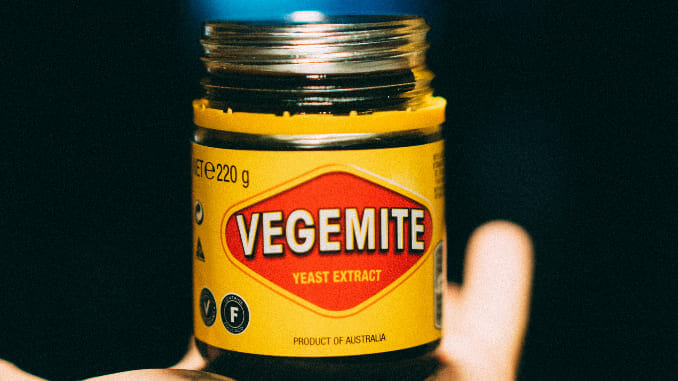
I hate Vegemite. There, I said it. It’s brown, goopy, pungent—all bad things in my book.
It’s not just Vegemite I hate but all yeast extracts (Marmite, its British precursor, too) that are meant to be dabbed onto hot toast with a liberal amount of butter. I tried it every which way when I lived in Australia (“the tiiiiiniest amount,” “add some avo mash,” “add cheese,” the Dairy Milk Vegemite chocolate bar), and I concluded that everything with Vegemite tastes better without it.
Or so I thought.
It turns out, I’ve been eating yeast extracts for a while—and enjoying them. Snuck into ingredient lists across the board, yeast extracts are a common additive in everything from pretzels to cottage cheese.
Although yeast extracts and umami are somewhat new to us, they’ve been a staple ingredient in Japanese cooking, says Bryan Quoc Le, Ph.D., food scientist and author of “150 Food Science Questions Answered. ” “Japanese culture was the first to use the concept of umami as a specific culinary taste, [and] Japanese scientists were able to isolate the compounds responsible for umami back in the early 20th century.
“Yeast extracts are produced by a process in which a yeast slurry is heated up to induce a process called autolysis in the yeast cells,” explains Le. “The process produces a large amount of an amino acid known as glutamic acid and two types of ribonucleotides, guanylates and inosinates. These three compounds together induce the high-intensity sensation of umami in the taste receptors on our tongue.”
In Japan, sake kasu, or sake lees, which are the yeast-rich remnants of sake production, are used to impart savoriness and flavor to pickles, meats, fish and soups, explains Le.
“Before, MSG, or monosodium glutamate, was widely used as an ingredient to increase umami notes, but now, yeast extracts are becoming more [commonly] used,” says Brian Chau, a food scientist and analyst at food consulting firm Chau Time. This, says Chau, is because yeast extract is perceived as a more natural additive. (An important aside: MSG is perfectly safe to use and consume in food despite lingering unscientific, racist myths.)
Recently, however, the use of yeast extracts is being deliberately revived with a surge in vegan cooking. This is in part because yeast extracts are rich in B vitamins, something vegan and vegetarian diets can sometimes lack. But it’s also because yeast extracts are an excellent source of umami, the savory taste that’s an enduring culinary buzzword.
Since umami compounds are typically found in high-protein foods such as meats, evolutionarily, tasting umami tells your body that you’ve found a protein source, which means you’re more likely to be satiated too.
Celia Brooks, a London-based vegetarian chef and author originally from Colorado, says yeast extract is one of her favorite “magic flavor enhancers.” Brooks recommends dissolving yeast extracts into vegetable stock: “[This] creates a meatiness while also enriching color—perfect for a vegetarian French onion soup or the base for a rich gravy.”
Brooks also suggests using yeast extracts sparingly in tomato-based pasta sauces and even Hollandaise for a surprising flavor upgrade.
Sparingly is the key for me, personally, and something I cannot stress enough. After having chanced on several videos involving unsuspecting Americans slathering Vegemite on toast like Nutella while researching this piece, I stress again: Less is more.
Lastly, says Brooks: “Yeast extract used instead of salt in caramel and chocolate desserts and sauces is sensational. Try it in homemade truffles, chocolate pots, brownies, toffee sauce and buttercream icing.”
I don’t quite know if I’m quite at the point where I’ll be adventurous enough to start adding yeast extracts to my brownie batter yet, but I can appreciate where and how that works. Nigella Lawson’s recipe for spaghetti with Marmite was my gateway into yeast extracts in everyday cooking, and I’ve since learnt (and this is where I stay true to my opening sentence) that I’m somehow partial to Marmite over Vegemite in my unending quest for umami. This makes sense, seeing as they each contain a varied blend of spices and vegetables, but where Vegemite has a slight sour tang and bitterness to it, Marmite is… mildly palatable on its own.
Personally, I’ve found that adding yeast extracts to cream-based sauces does something to instantly lift the dish. And for tomato- and meat-based sauces that typically taste better the next day, the tiniest dot of Marmite grounds the dish, and you get that mellowness almost instantly.
Maybe one day I’ll be open to scooping some out into a slow-simmering pot of daal makhani (I’ve seen it listed in ready-made Indian spice mixes) or a dhaba-style chicken curry. For now, though: baby steps.
*an experience I would like to unlive
Akanksha Singh is a journalist based between Mumbai, India, and Lisbon, Portugal. Her work has appeared in Bon Appétit, CNN, Lonely Planet, Saveur and more. Read her work here, her tweets here, and about the time Nigella Lawson called her toaster oven madeleines “beautiful” over on Instagram.